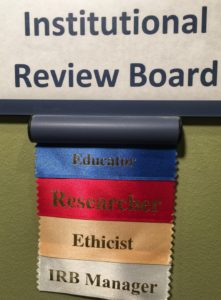At the 2018 Advancing Ethical Research Conference, attendees selected from networking ribbons displayed in the on-site check-in area that emphasized an array of professional roles and affiliations. The networking ribbons offered an engaging way to initiate conversations with other attendees. I opted to organize my ribbons in the following order: Educator, Researcher, Ethicist, and IRB Manager. The networking ribbons represented my professional origin story and captured my journey into the world of research compliance.

Origin stories can help solidify goals and establish priorities for administrators and researchers. Presenters Michael Leary, MA, and Gianna McMillan, MA, conveyed the importance of stories and the use of narratives in IRB member education during their conference presentation.
While there are countless stories that emphasize the importance of ethical practices in research, the book The Immortal Life of Henrietta Lacks by Rebecca Skloot is one of the most accessible and profound.
To briefly summarize the book, in 1951 thirty-year-old Henrietta Lacks was diagnosed with cervical cancer and treated with radium and x-ray therapy. Some of her cancer tissue was removed and sent to George Gey’s lab at Johns Hopkins Hospital to be cultured, a feat that had been repeatedly attempted with no success. Lacks’ cells proved to be robust and thrived in the lab, providing researchers with endless cancer cells for scientific experimentation over the ensuing decades. Science writer Rebecca Skloot worked with the Lacks family in an effort to tell the story of Henrietta’s life and her contribution to science and medicine.
The Lacks family knew a little about Henrietta’s cells (called HeLa cells). However, they did not have a clear understanding of what HeLa cells were, where they came from, or what it meant when doctors and scientists said that Henrietta’s cells were “immortal.”
The Lacks family largely distrusted Skloot, the media, and the scientific community because neither Henrietta nor any of her family members knew about nor authorized the tissue sample extraction, cultivation, and distribution.
Henrietta Lacks’ story (and many like hers) offer examples for IRB administrators to engage in ethical discussions, provoke questions, and describe the role of IRB in research and informed consent in research practices. For example, IRB educators can use Lacks’ story to explore ethical topics like:
Ethical Oversight and Policy
- What ethical oversight (if any) is needed for an indefinite number of research projects on cells, and when is consent from an authorized third party necessary?
- What policies exist concerning the collection, storage, and research use of biospecimens and data?
- How often are biospecimens obtained from one individual particularly valuable? Does this factor weigh into ethical policy creation?
Data Sharing and Large Data Sets
- What are the implications of large-scale sharing of genomic data sets (often required by many funding sources and journals) to promote replication of findings and further research?
Informed Consent and Confidentiality
- Were Henrietta’s cells identifiable after they were cultured outside of her body?
- Did Henrietta provide any instructions for future use of her cells, research on her cells, or distribution of her cells during her life or after her death?
- What are researchers’ responsibilities for informed consent, oversight, large-scale data sharing, privacy and confidentiality, commercialization, and access to research results?
- How clearly are regulations and guidelines concerning informed consent defined when specifically related to biospecimen research?
Public Health Practices vs. Research
- Were Henrietta’s cells collected as part of typical clinical care?
- What safeguards are in place today for protecting the patient during typical clinical care?
- How are the safeguards of typical clinical care different from research related activities?
If Henrietta Lacks were a patient in the United States today, biospecimens collected solely for her clinical care would likely not require her consent for use in research. Further, in the United States, research involving deceased individuals is not human subjects research (according to 45 CFR 46.102(f)) and does not require IRB oversight. Therefore, the proposed research on Henrietta’s cells would likely be exempt from the Common Rule.
The Immortal Life of Henrietta Lacks also traces the history of ethics regulations over time. Tracing this historical timeline and narrative is useful for IRB administrators interested in discussing what research approaches were acceptable in 1951 versus today.
Stories engage audiences, inspire debate, and offer concrete examples of ethical issues and can increase sensitivity to local contexts or relevant issues. Narratives can help researchers comprehend ethical reasoning by offering a richer way to understand principles that are oversimplified when presented as a list of rules. Oral histories and narrative resources offer IRB Administrators the opportunity to track the evolution of research ethics. Personal stories about healthcare and research experiences, and commentaries about bioethics enrich IRB instruction and dissemination.
The session presenters offered additional resources for further exploration on the role of narrative in IRB education. They also suggested that IRB administrators can collect narratives from their own institutions to add to their repertoire. These narratives can come from participant or researcher experiences or their own personal stories rooted in research administration.
Narrative in IRB Education Resources
Anderson, E.E., Solomon, S., Heitman, E., DuBois, J.M., Fisher, C.B., Kost, R.G., Lawless, M.E., Ramsey, C., Jones, B., Ammerman, A. and Ross, L.F., (2012). Research ethics education for community-engaged research: A review and research agenda. Journal of Empirical Research on Human Research Ethics, 7(2), 3-19.
Camporesi, S., Vaccarella, M., & Davis, M. (2017). Investigating public trust in expert knowledge: Narrative, ethics, and engagement. Journal of bioethical inquiry, 14(1), 23-30.
Charon, R., & Montello, M. (Eds.). (2004). Stories matter: The role of narrative in medical ethics. Routledge.
Dresser, R. (2016). Silent partners: Human subjects and research ethics. Oxford University Press.
Frank, A. W. (2013). The wounded storyteller: Body, illness, and ethics. University of Chicago Press.
Hung, Y., Ayala, A., Morales, F., Frierman-Hunt, G., Moreno, A., & Nwachuku, I. (2013). Sustaining Engagement and Partnership: A Model of Enhancing Cultural Capital among Nonaffiliated IRB Members. Journal of Empirical Research on Human Research Ethics, 8(3), 34-45.
Piper, M. (2017). Mass-audience interactive narrative ethical reasoning instruction. International Journal of Ethics Education, 2(2), 161-173.
Sim, K., Sum, M. Y., & Navedo, D. (2015). Use of narratives to enhance learning of research ethics in residents and researchers. BMC medical education, 15(1), 41.
Myra Luna-Lucero, EdD, is a Research Compliance Manager at the Teacher’s College of Columbia University. As a researcher and teacher, people are her highest priority and she instinctively communicates personal concern with others. She is an adept communicator who thrives on face-to-face interactions with a diverse body of students, faculty, and staff. She brings these qualities to her work to empower others to make informed decisions and reach their goals. She encourages researchers to ponder the roles they might play in the alleviation of the troubling inequities that continue to shape our world. She guides researchers on how to treat everyone as autonomous decision-makers who possess unique opinions. I present campus workshops on the importance of ethics, confidentiality, and protecting vulnerable populations. She meets individually with researchers to strategize ways to protect human subjects and do good work in the world.
Members of PRIM&R’s Blog Squad and other guest contributors are valued members of our community willing to share their insights. The views expressed in their posts do not necessarily reflect those of PRIM&R or its employees.


No comments! Be the first commenter?